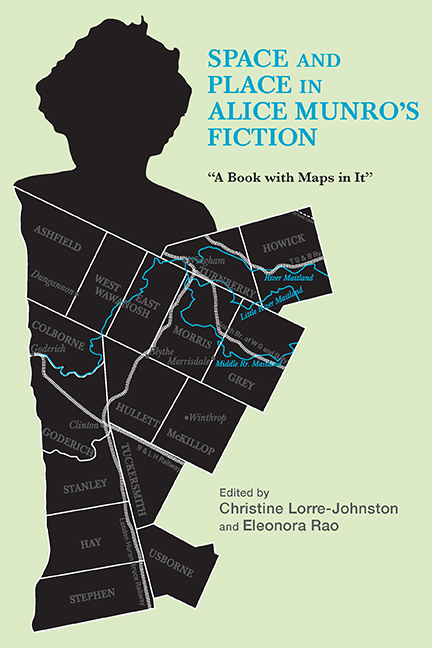Book contents
- Frontmatter
- Contents
- List of Illustrations
- Acknowledgments
- List of Abbreviations
- Introduction
- Part I Conceptualizing Space and Place: Houses, Landscapes, Territory
- 1 Where Do You Think You Are? Alice Munro's Open Houses
- 2 “Whose House Is That?” Spaces of Metamorphosis in Alice Munro's Dance of the Happy Shades, Who Do You Think You Are?, and The View from Castle Rock
- 3 Mapping the Vernacular Landscape in Alice Munro's “What Do You Want to Know For?” and Other Stories
- 4 Stories in the Landscape Mode: A Reading of Alice Munro's “Lives of Girls and Women,” “Walker Brothers Cowboy,” and “Lichen”
- 5 “What Place Is This?” Alice Munro's Fictional Places and Her Place in Fiction
- 6 “The Emptiness in Place of Her”: Space, Absence, and Memory in Alice Munro's Dear Life
- 7 Down the Rabbit Hole: Revisiting the Topos of the Cave in Alice Munro's Short Stories
- Part II Close Readings of Space and Place
- Bibliography
- Notes on the Contributors
- Index
1 - Where Do You Think You Are? Alice Munro's Open Houses
from Part I - Conceptualizing Space and Place: Houses, Landscapes, Territory
Published online by Cambridge University Press: 15 August 2018
- Frontmatter
- Contents
- List of Illustrations
- Acknowledgments
- List of Abbreviations
- Introduction
- Part I Conceptualizing Space and Place: Houses, Landscapes, Territory
- 1 Where Do You Think You Are? Alice Munro's Open Houses
- 2 “Whose House Is That?” Spaces of Metamorphosis in Alice Munro's Dance of the Happy Shades, Who Do You Think You Are?, and The View from Castle Rock
- 3 Mapping the Vernacular Landscape in Alice Munro's “What Do You Want to Know For?” and Other Stories
- 4 Stories in the Landscape Mode: A Reading of Alice Munro's “Lives of Girls and Women,” “Walker Brothers Cowboy,” and “Lichen”
- 5 “What Place Is This?” Alice Munro's Fictional Places and Her Place in Fiction
- 6 “The Emptiness in Place of Her”: Space, Absence, and Memory in Alice Munro's Dear Life
- 7 Down the Rabbit Hole: Revisiting the Topos of the Cave in Alice Munro's Short Stories
- Part II Close Readings of Space and Place
- Bibliography
- Notes on the Contributors
- Index
Summary
Compared to the other houses in town, hers appeared to have no secrets, no contradictions. What people said was, “It's such a pretty house, doesn't look real.”
—Alice Munro, Lives of Girls and WomenTHE FELT NEED for literary criticism to develop a more rigorous approach to the spaces in and of fiction—attending to how fiction occupies and configures space, how geography and fiction intersect and inform one another, and how space plays a fundamental role in reading— arises partly from the insights of fiction itself in addressing its spatiality. Linda Hutcheon has identified in postmodern fiction a tendency toward what she calls “historiographic metafiction,” a fiction that, even as it tells a historical story, comments upon its own writing of history: its involvements, its processes, its limitations. In this essay I argue that in fiction such as Alice Munro's there is also a geographic metafiction, a fiction that, even as it configures space and place, examines its own ability to do so. A reading of “Vandals,” the final story in Munro's 1994 collection, Open Secrets, demonstrates that Munro's fiction makes use of its own spatial form to comment on the places it evokes within its narrative, while the representation of those places self-reflexively comments in turn on the space of the story.
To refer to Munro's stories as open houses is to nod to her titular phrase “open secrets” in the belief that the two concepts are often synonymous in her work. The house is a central figure in Munro's fiction, frequently appearing as a place infused with secrets, as evidenced by the much-cited assertion in her book Lives of Girls and Women that people's lives are “deep caves paved with kitchen linoleum” (LiGW, 249). The social custom of the open house, meanwhile, carries with it the implication that, like writers of fiction, the people who host such events are making intimate, hidden things available and knowable to others.
- Type
- Chapter
- Information
- Space and Place in Alice Munro's Fiction“A Book with Maps in It”, pp. 27 - 40Publisher: Boydell & BrewerPrint publication year: 2018



